Every organization wants and needs good leadership to ensure success. How would you know, though, if a person has just the right kind of skills to take the reins of a team or lead a company? Leadership assessments make it easy to get the answers. Leadership assessments are meant to measure a person’s leadership potentials, which can make the process of hiring the right people easier and help current leaders continue to grow and improve. We’ll go over exactly what leadership assessments are and how they benefit organizations as we dig deeper into this article.
- What Are Leadership Assessments?
- Benefits of Leadership Assessments for Hiring and Working
- 4 Online Leadership Assessment Platforms for HR Managers
- How to Make A Leadership Assessment Using OnlineexamMaker?
- Best Practices to Making A Leadership Quiz
What Are Leadership Assessments?

Leadership assessment could be defined as tests or processes used to measure a person’s ability, capacity, and style of leadership. Most assessments are aimed at measuring an extensive set of characteristics, starting from communication skills and emotional intelligence and moving all the way to decision-making ability, adaptability, and conflict management. These can be provided in many forms like questionnaires, interviews, various simulations, and even 360-degree feedbacks.
These tools help show where the person stands. Is this person a natural-born leader, or does he or she need development in certain areas? These are the kinds of answers provided by leadership assessment, making the task of putting the right person in the best role or creating a development plan that maximizes their leadership potential that much easier.
There are many varieties of leadership assessments, including:
Personality-based assessments
These would gauge personality traits on aspects such as introversion, extroversion, agreeableness, and conscientiousness. These are a starting point in finding the natural tendencies of a leader and how he or she handles a particular situation.
Skills assessment
This gauges skills in applied leadership across communication, conflict resolution, and strategic thinking.
Behavioral evaluations put a number on how a leader acts in specific situations, such as under stress or leading a team through change.
This is achieved through soliciting the opinions of people from different levels of associates, such as supervisors, daily friends/colleagues, and subordinates, so that one gets feedback in a full circle on his leadership style and effectiveness.
Each one of those constitutes another layer of insight enabling the company to make informed decisions about leadership hires or development paths.
You might like to know
Create an auto-grading leadership assessment without any coding – try OnlineExamMaker today!
Benefits of Leadership Assessments for Hiring and Working
Leadership tests represent a significant amount of value, both during the hiring process and in the work environment. Now, let’s discuss some major benefits:
Better hiring decisions
Finding the right man or woman for the job is usually critical. Leadership assessments contribute to enabling a company to look beyond gut feelings or resumes and to get a clearer picture of what each candidate actually is capable of.
They help answer questions like:
• Can he/she lead and inspire a team?
• Whether they are indicative of their critical decision-making abilities when under pressure?
• Do they possess the emotional quotient to handle complex interpersonal issues?
These assessments help the hiring managers through which the chances of promoting or hiring a person in organizations who may not turn out to be good are reduced. They also help make sure you’re selecting someone with the right mix of skills, personality, and leadership potential that best matches the culture and goals of the company.
Development of the current leaders
For leaders already in their positions, assessments become the route to personal growth. Probably, an evaluation as a leader would show that although he or she is great at thinking strategically, one may fail in team communication. Having this knowledge, they know where to put the emphasis on improving while still leaning on the strengths.
This steady assessment allows for constant development; a leader will thus be continuously improving his or her skills as he or she advances up the career ladder. You would, in a sense, have your personal guide on how to be a better leader based on your strengths and challenges.
Improve team performance
As a matter of fact, leadership pertains directly to team performance. If the leader can understand the strengths and weaknesses, then he will surely try to improve them. More motivated workforce, better communication, and a better work environment are guaranteed results of that attempt. In fact, leadership assessments can effectively create self-awareness necessary for leaders to help foster better relationships, align people toward common goals, and drive higher performance.
Better succession planning
Succession planning for the thinking company is an effective tool in leadership assessments. They classify budding potential for future leadership and guide them towards development so that, at such a time when promotion or a change in leadership is required, they have a well-prepared candidate to step into its shoes. It’s a proactive way to ensure that leadership transitions take place without any hiccups to teams and goals of organizations.
Strong company culture is fostered
Leadership assessments can also build and help maintain great company culture. Developing and assessing leaders for their alignment with the company’s values means their leadership styles foster and reinforce core principles of the organization. It cultivates more cohesive teams with higher morale and a more united purpose.
Diversification of leadership
Apparently, another major benefit of leadership assessments is that they reduce bias in selection and promotion. For example, traditional ways in which a company may choose leaders-such as by “gut feelings” or other subjective opinions-can result in unconscious bias and missed opportunities. Assessments, by focusing on objective criteria, allow a more diverse range of candidates to be able to shine. In this case, leadership teams are more inclusive; such teams perform a lot better, as studies show, because diverse points of view and experiences are brought to the table.
4 Online Leadership Assessment Platforms for HR Managers
OnlineExamMaker
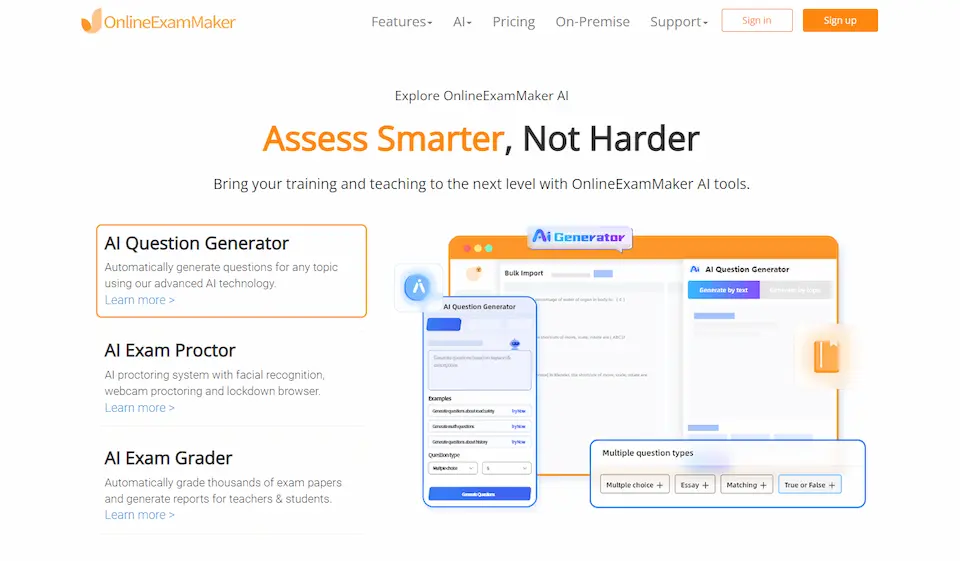
G2 Rating: 4.7/5
Key Features:
• Powerful AI tools for question generation and grading.
• Provides leadership assessment templates to cater to particular organizational needs.
• Real-time data analytics allow progress monitoring and making informed decisions about leadership potentials.
• Supports various question formats: multiple choice; essay type; performance tasks that evaluate a range of leadership competencies.
• Allows for easy integration with other human resource tools for effective evaluations and reporting.
OnlineExamMaker.com is a powerful website that will enable any human resources manager to assess leadership potential in a very user-friendly and easily customizable manner. Equipped with a large number of ready-to-use templates, the software enables HR teams to design assessments that test critical leadership traits such as decision-making, emotional intelligence, and team-management skills. The analytics within the tool provide real-time insight into how candidates perform, making it much easier to pinpoint top talent or areas where they may need to develop further.
Also, OnlineExamMaker stands out because its chief strength lies in integration with already existing HR systems within businesses of all sizes, thus making it flexible and efficient. It’s a perfect option for any HR team that needs a strong yet adaptable leadership assessment platform.
Create Your Next Quiz/Exam with OnlineExamMaker
HireVue

G2 Rating: 4.1/5
Key Features:
• Utilizes the science of artificial intelligence and video-based assessment for leadership competencies in decision-making and communication skills.
• It allows candidates to take the assessments remotely and at a convenient time.
• The insights are comprehensive in terms of data output to enable HR managers to make informed hiring decisions.
• Integrated with most recruitment ATS to make hiring seamless.
HireVue is an in-depth recruitment platform for HR looking to screen leadership potential, moderated by advanced AI technology. It evaluates the main parameters of leadership personality, including emotional intelligence and problem-solving ability, through video interviews and AI-generated analysis.
Advanced algorithms processing the responses of candidates will help project job performance and improve the decisions of HR teams when selecting future leaders. Such flexibility of HirеVUE in remote interviewing and seamless integration with ATS makes it a perfect choice for companies that manage high-volume recruitment processes while still catching the top leadership candidates that might get missed.
Talview
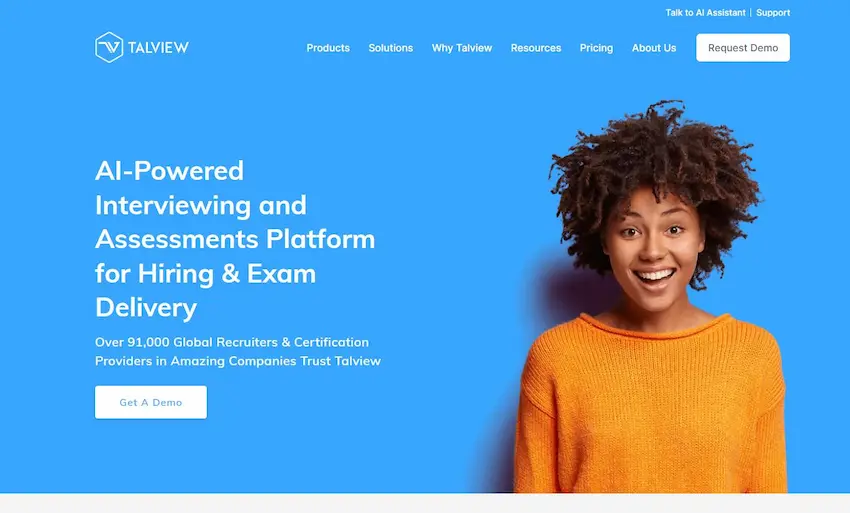
G2 Rating: 4.4/5
Key Features:
• Integrates AI and behavioral science to assess leadership competencies in matters but not limited to decision-making and adaptability.
• It contains comprehensive reporting and analytics so that the HR manager can interpret the leadership strengths and weaknesses of a candidate.
• Supports video interviews and remote assessments, hence flexible for global teams.
Talview grants HR managers an all-in-one assessment platform to evaluate leadership potential by mixing AI, behavioral science, and video interviews. It provides organisations with insight into decision-making and emotional intelligence in a way no other tool can, helping organisations uncover great leaders. With Talview, automated proctoring ensures fairness and security in assessments even from remote locations.
With its reporting and analytics, HR professionals can dive deep to understand the candidates for leadership competencies. Talview’s new approach to leadership assessments has proven to be highly adaptive, technologically driven, and corrects companies needing a global solution with flexibility.
PredictiveIndex
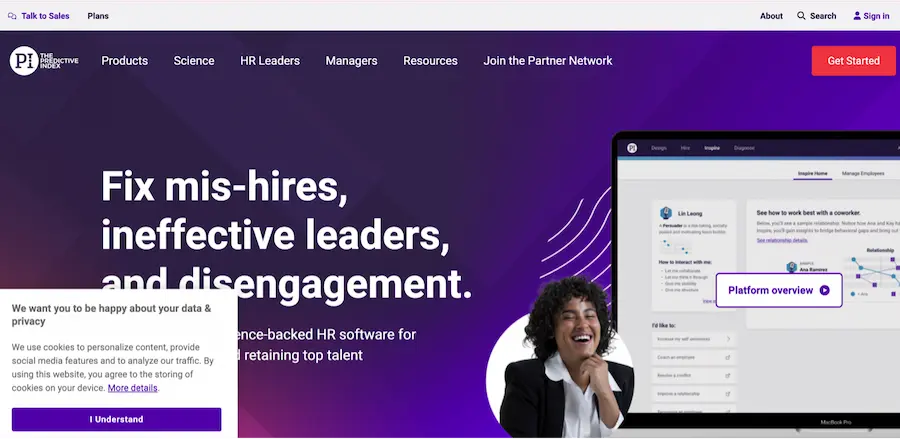
G2 Rating: 4.7/5
Key Features:
• Focuses more on the assessment of behaviors for leadership potentials, considering the work style and personality traits.
• Ensuring assessment creation, delivery, and analysis is done through a very user-friendly manner by the HR manager.
• Offers robust reporting tools that map candidate behaviors against key job requirements.
• Supports seamless integration with most of the HR platforms for smooth implementation and sharing of data.
PredictiveIndex is a platform for behavioral assessments that designs and develops insight into personalities and work styles to assist HR managers in recognizing leadership potentials. It finds applications in companies embracing data-informed decisions within their hiring and development. The behavioral assessments on this platform provide insight into how a candidate might approach challenges, communicate with teams, and lead others.
This information can be used by the HR manager to align the candidates with the most suitable leadership roles based on their existing propensities; hence, this might prove to be a great instrument for companies that want to come closer to perfection in optimizing their leadership pipeline. Its integration capabilities and detailed reporting make it an extremely capable solution for data-driven HR teams.
How to Make A Leadership Assessment Using OnlineexamMaker?
Creating an online leadership assessment is super-easy and effective if one uses the right tool. Follow this step-by-step guide on how to create a leadership assessment using OnlineExamMaker.
Step 1: Login and open OnlineExamMaker
Log in to your OnlineExamMaker account. This will open the complete feature set you need to make your leadership assessment.
Create Your Next Quiz/Exam with OnlineExamMaker
Step 2: Include leadership assessment questions
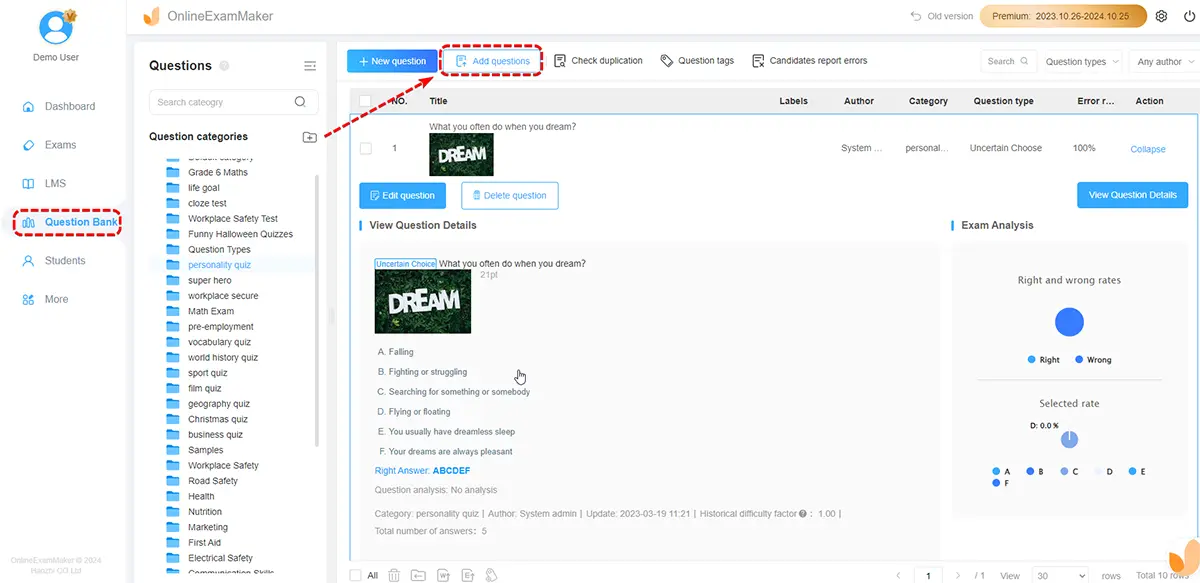
OnlineExamMaker gives you two options in which to add your questions for assessment.
• AI Question Generator: Launch OnlineexamMaker AI Question Generator, add keywords related to leadership, and the software will generate questions automatically.
• Questions Manually Created: You can utilize the question editor in the program to create your own questions, which can include rich media such as images or videos.
• Bulk Upload: This option is given so that you can upload all the questions if you have already created them in Excel; thus, it saves time.
Step 3: Create a leadership assessment
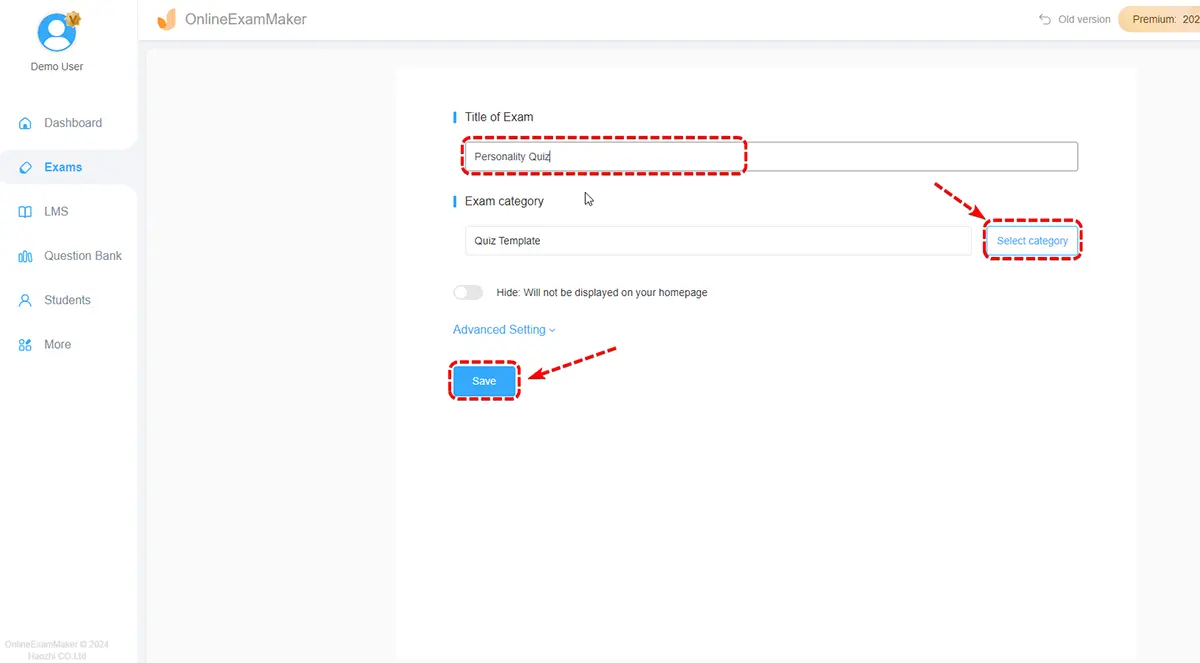
Click the “New exam” button to proceed with building your leadership assessment. At this stage, you add the questions you have prepared and set up the structure of the assessment.
Step 4: Adjustment of assessment

Make the assessment look like, or be in sync with, your brand by changing the color scheme to your tone and adding your firm’s logo. Further, you will be able to configure key features like time limits, grading options, and online proctoring for smoothness in the whole assessment process.
Step 5: Publishing and sharing leadership assessment
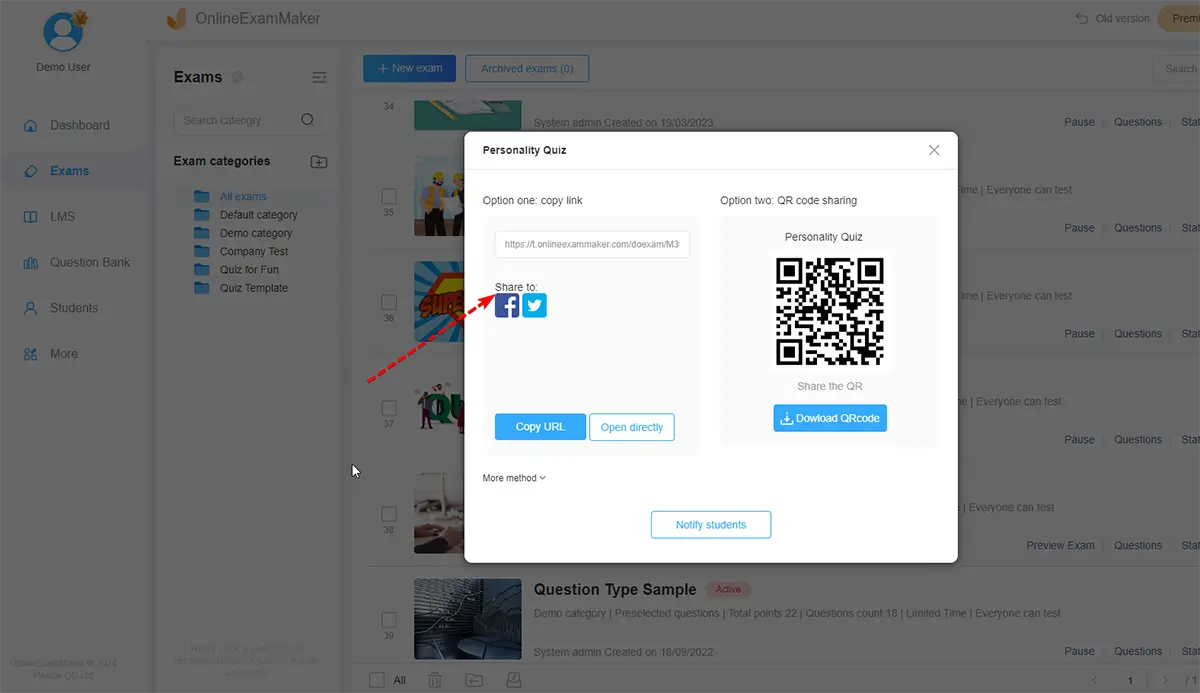
Once you are ready to go live with your leadership assessment, OnlineExamMaker will provide both a direct link and a quick response, or QR code. You can share either of these with your candidates for easy access to the assessment.
Best Practices to Making A Leadership Quiz
1. Clearly established leadership traits and skills
Identify the main areas first that you want to assess, such as it could be communication, making decisions, emotional intelligence, or handling a team. Adjust the quiz for particular leadership qualities important to your company. This way, it settles with company culture and expectations of leadership.
2. Use varied question types
Employ various questioning methods, for example, multiple-choice questions, situational judgment, and open-ended questions, to obtain a well-rounded view of the participant’s leadership skills. Real-life situations can be presented to find out how practical decision-making abilities could turn out and how candidates in leadership would handle the challenge situations.
3. Questions to be asked should be clear and significant
Also, ensure your questions are straightforward, as ambiguous questions make it difficult for the participant to understand what is being looked for. Clear questions ensure that more realistic and valid information is obtained.
4. Keep the quiz short
Limit yourself to essential questions that can be realistically responded to within a real time frame. Very long questionnaires lead to loss of interest and fatigue that might affect the quality of responses.
5. Provide clear instructions
Instructions at the start of the quiz help to direct the respondent through the remainder with ease, thereby reducing confusion on the part of the test-taker in such an exercise.
6. Piloting the quiz
It would also be good to consider piloting the quiz on a small group for feedback on items of clarity and relevance. This can help make adjustments to improve the effectiveness of the quiz before its full release to the organization.